Research Process: Staff Motivation and Productivity in Healthcare
VerifiedAdded on 2022/11/29
|14
|4403
|297
Report
AI Summary
This research report investigates the impact of staff motivation on productivity within a healthcare setting, specifically focusing on Saint Lucia. The report begins with an introduction highlighting the importance of staff motivation in improving organizational performance and patient care, and then it outlines the research objectives, which include analyzing the link between staff motivation and productivity. The methodology section details the use of an abductive research approach, favoring an inductive approach for data analysis. The report validates the research tools, particularly emphasizing the use of inductive reasoning for qualitative data collection and analysis. It also discusses the application of both primary and secondary data collection methods, including interviews and surveys, while differentiating between qualitative and quantitative research approaches. The report examines the advantages and disadvantages of both qualitative and quantitative methods. The report addresses the research title, research tools validation, data collection methods, and the differences between qualitative and quantitative approaches. The report also includes a literature review, methodology, and data analysis plan, concluding with a discussion of ethical considerations, limitations, and a proposed timeline and budget for the research. The assignment incorporates material from weeks 4-7 of the module, ensuring a theoretically sound and practical approach to data collection and analysis, aiming to provide a comprehensive understanding of the research topic.
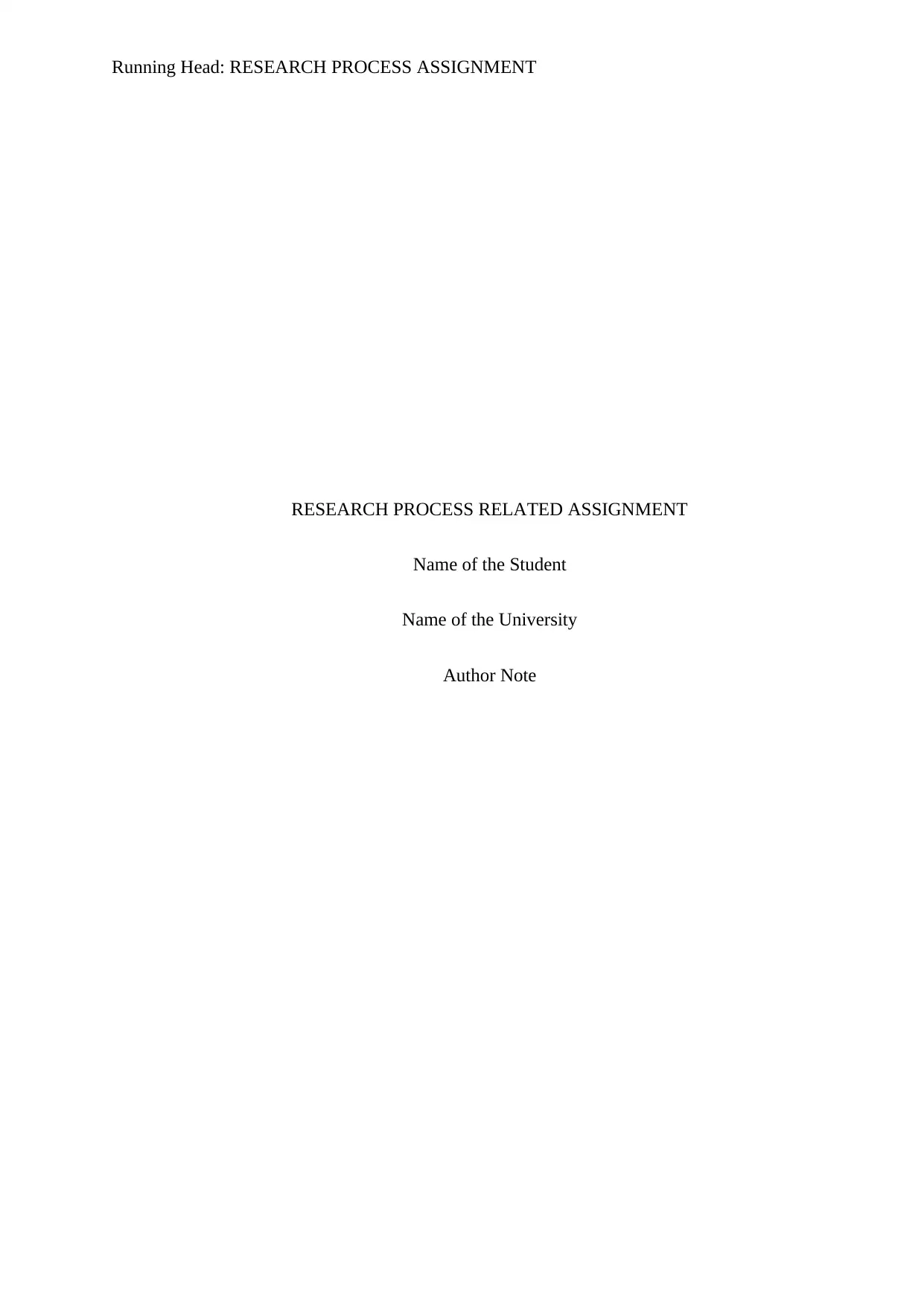
Running Head: RESEARCH PROCESS ASSIGNMENT
RESEARCH PROCESS RELATED ASSIGNMENT
Name of the Student
Name of the University
Author Note
RESEARCH PROCESS RELATED ASSIGNMENT
Name of the Student
Name of the University
Author Note
Paraphrase This Document
Need a fresh take? Get an instant paraphrase of this document with our AI Paraphraser
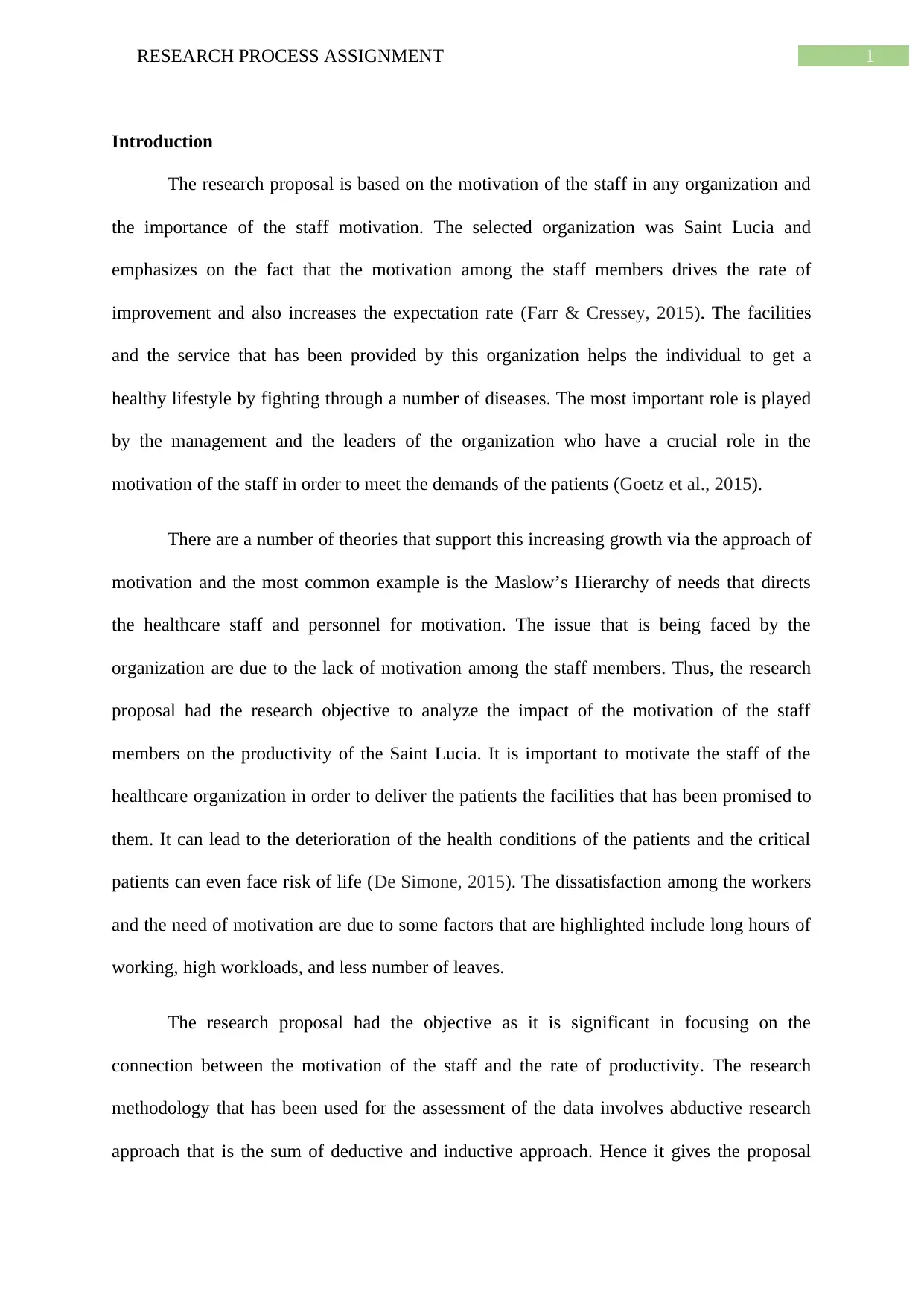
1RESEARCH PROCESS ASSIGNMENT
Introduction
The research proposal is based on the motivation of the staff in any organization and
the importance of the staff motivation. The selected organization was Saint Lucia and
emphasizes on the fact that the motivation among the staff members drives the rate of
improvement and also increases the expectation rate (Farr & Cressey, 2015). The facilities
and the service that has been provided by this organization helps the individual to get a
healthy lifestyle by fighting through a number of diseases. The most important role is played
by the management and the leaders of the organization who have a crucial role in the
motivation of the staff in order to meet the demands of the patients (Goetz et al., 2015).
There are a number of theories that support this increasing growth via the approach of
motivation and the most common example is the Maslow’s Hierarchy of needs that directs
the healthcare staff and personnel for motivation. The issue that is being faced by the
organization are due to the lack of motivation among the staff members. Thus, the research
proposal had the research objective to analyze the impact of the motivation of the staff
members on the productivity of the Saint Lucia. It is important to motivate the staff of the
healthcare organization in order to deliver the patients the facilities that has been promised to
them. It can lead to the deterioration of the health conditions of the patients and the critical
patients can even face risk of life (De Simone, 2015). The dissatisfaction among the workers
and the need of motivation are due to some factors that are highlighted include long hours of
working, high workloads, and less number of leaves.
The research proposal had the objective as it is significant in focusing on the
connection between the motivation of the staff and the rate of productivity. The research
methodology that has been used for the assessment of the data involves abductive research
approach that is the sum of deductive and inductive approach. Hence it gives the proposal
Introduction
The research proposal is based on the motivation of the staff in any organization and
the importance of the staff motivation. The selected organization was Saint Lucia and
emphasizes on the fact that the motivation among the staff members drives the rate of
improvement and also increases the expectation rate (Farr & Cressey, 2015). The facilities
and the service that has been provided by this organization helps the individual to get a
healthy lifestyle by fighting through a number of diseases. The most important role is played
by the management and the leaders of the organization who have a crucial role in the
motivation of the staff in order to meet the demands of the patients (Goetz et al., 2015).
There are a number of theories that support this increasing growth via the approach of
motivation and the most common example is the Maslow’s Hierarchy of needs that directs
the healthcare staff and personnel for motivation. The issue that is being faced by the
organization are due to the lack of motivation among the staff members. Thus, the research
proposal had the research objective to analyze the impact of the motivation of the staff
members on the productivity of the Saint Lucia. It is important to motivate the staff of the
healthcare organization in order to deliver the patients the facilities that has been promised to
them. It can lead to the deterioration of the health conditions of the patients and the critical
patients can even face risk of life (De Simone, 2015). The dissatisfaction among the workers
and the need of motivation are due to some factors that are highlighted include long hours of
working, high workloads, and less number of leaves.
The research proposal had the objective as it is significant in focusing on the
connection between the motivation of the staff and the rate of productivity. The research
methodology that has been used for the assessment of the data involves abductive research
approach that is the sum of deductive and inductive approach. Hence it gives the proposal
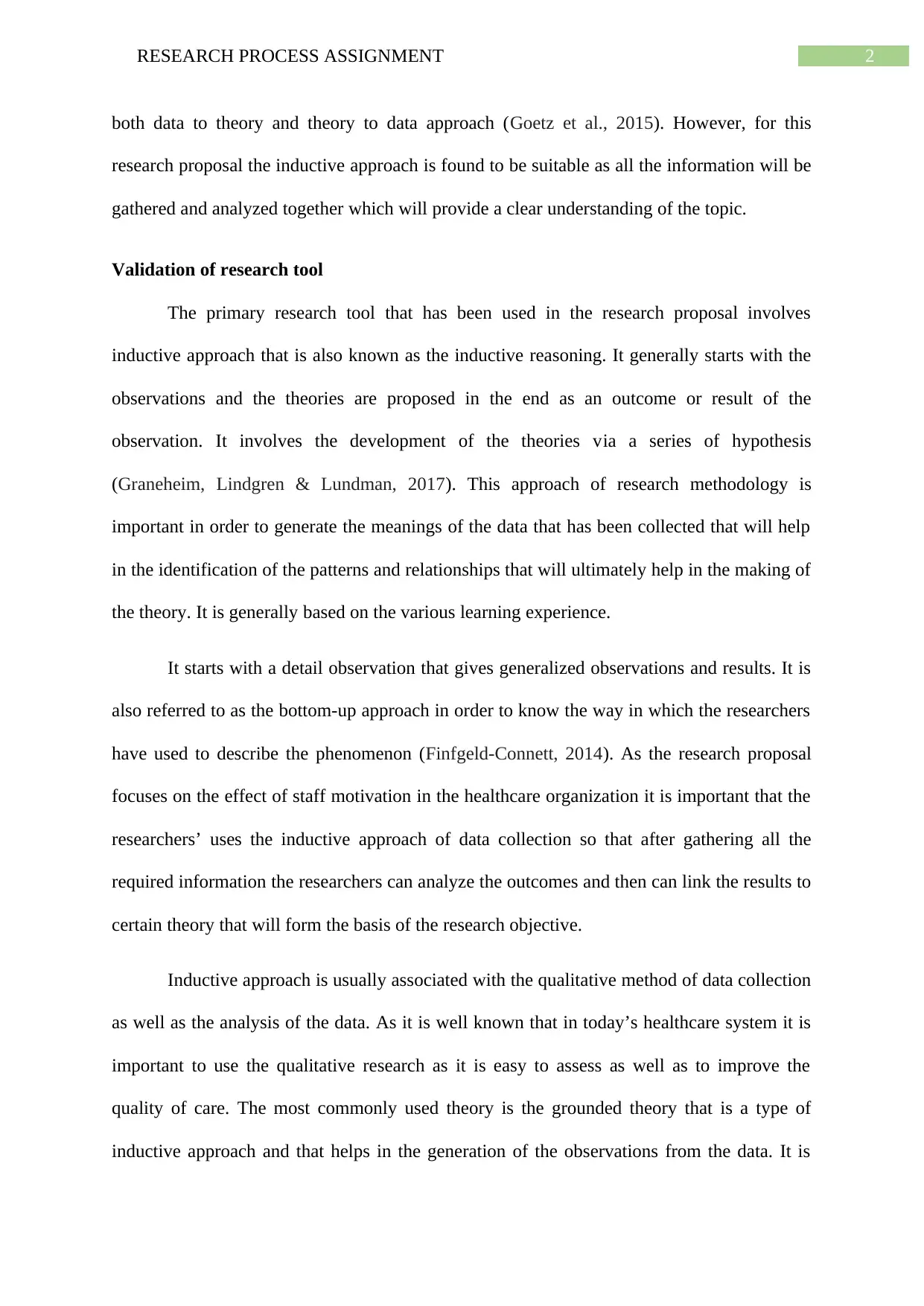
2RESEARCH PROCESS ASSIGNMENT
both data to theory and theory to data approach (Goetz et al., 2015). However, for this
research proposal the inductive approach is found to be suitable as all the information will be
gathered and analyzed together which will provide a clear understanding of the topic.
Validation of research tool
The primary research tool that has been used in the research proposal involves
inductive approach that is also known as the inductive reasoning. It generally starts with the
observations and the theories are proposed in the end as an outcome or result of the
observation. It involves the development of the theories via a series of hypothesis
(Graneheim, Lindgren & Lundman, 2017). This approach of research methodology is
important in order to generate the meanings of the data that has been collected that will help
in the identification of the patterns and relationships that will ultimately help in the making of
the theory. It is generally based on the various learning experience.
It starts with a detail observation that gives generalized observations and results. It is
also referred to as the bottom-up approach in order to know the way in which the researchers
have used to describe the phenomenon (Finfgeld-Connett, 2014). As the research proposal
focuses on the effect of staff motivation in the healthcare organization it is important that the
researchers’ uses the inductive approach of data collection so that after gathering all the
required information the researchers can analyze the outcomes and then can link the results to
certain theory that will form the basis of the research objective.
Inductive approach is usually associated with the qualitative method of data collection
as well as the analysis of the data. As it is well known that in today’s healthcare system it is
important to use the qualitative research as it is easy to assess as well as to improve the
quality of care. The most commonly used theory is the grounded theory that is a type of
inductive approach and that helps in the generation of the observations from the data. It is
both data to theory and theory to data approach (Goetz et al., 2015). However, for this
research proposal the inductive approach is found to be suitable as all the information will be
gathered and analyzed together which will provide a clear understanding of the topic.
Validation of research tool
The primary research tool that has been used in the research proposal involves
inductive approach that is also known as the inductive reasoning. It generally starts with the
observations and the theories are proposed in the end as an outcome or result of the
observation. It involves the development of the theories via a series of hypothesis
(Graneheim, Lindgren & Lundman, 2017). This approach of research methodology is
important in order to generate the meanings of the data that has been collected that will help
in the identification of the patterns and relationships that will ultimately help in the making of
the theory. It is generally based on the various learning experience.
It starts with a detail observation that gives generalized observations and results. It is
also referred to as the bottom-up approach in order to know the way in which the researchers
have used to describe the phenomenon (Finfgeld-Connett, 2014). As the research proposal
focuses on the effect of staff motivation in the healthcare organization it is important that the
researchers’ uses the inductive approach of data collection so that after gathering all the
required information the researchers can analyze the outcomes and then can link the results to
certain theory that will form the basis of the research objective.
Inductive approach is usually associated with the qualitative method of data collection
as well as the analysis of the data. As it is well known that in today’s healthcare system it is
important to use the qualitative research as it is easy to assess as well as to improve the
quality of care. The most commonly used theory is the grounded theory that is a type of
inductive approach and that helps in the generation of the observations from the data. It is
⊘ This is a preview!⊘
Do you want full access?
Subscribe today to unlock all pages.

Trusted by 1+ million students worldwide
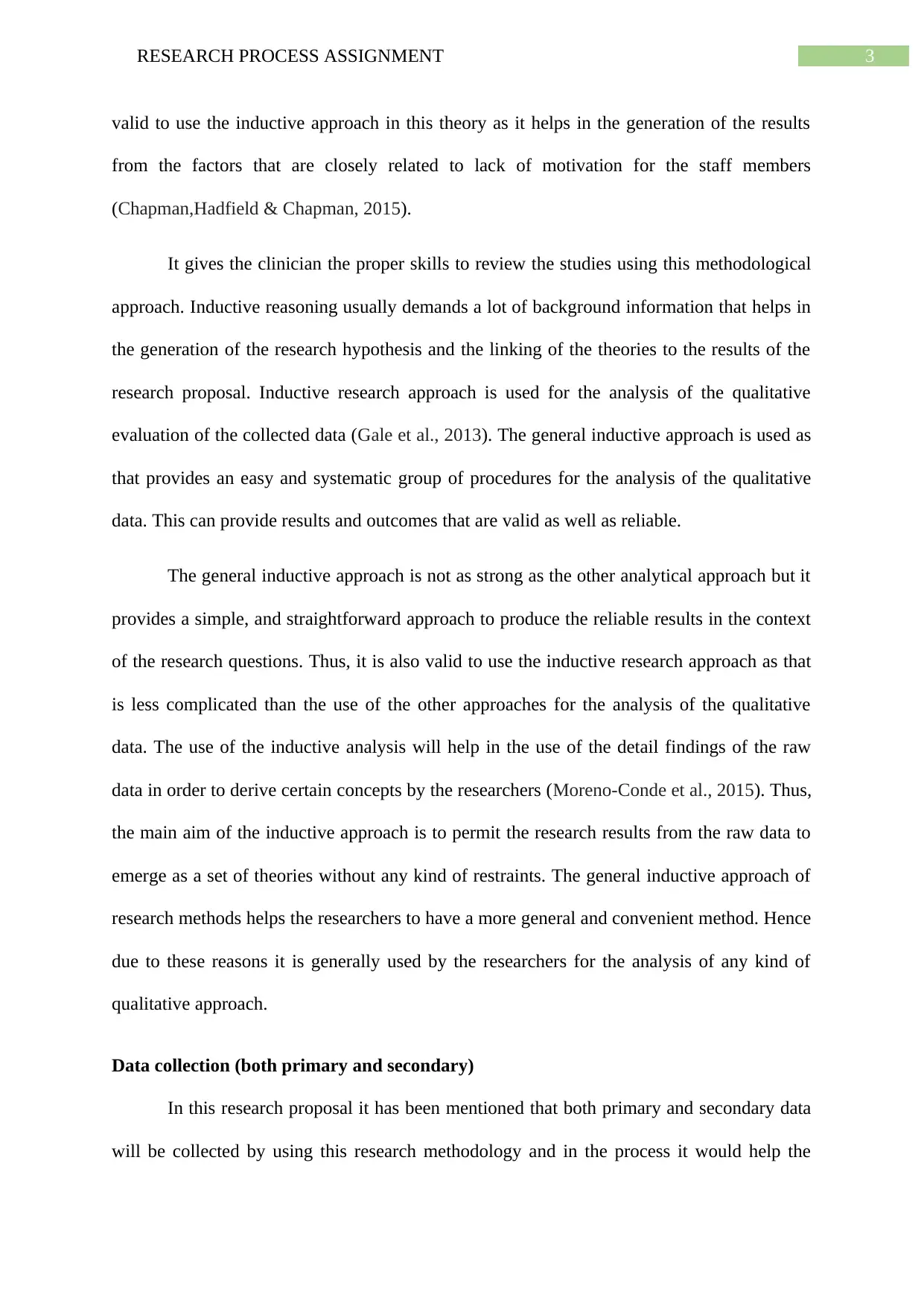
3RESEARCH PROCESS ASSIGNMENT
valid to use the inductive approach in this theory as it helps in the generation of the results
from the factors that are closely related to lack of motivation for the staff members
(Chapman,Hadfield & Chapman, 2015).
It gives the clinician the proper skills to review the studies using this methodological
approach. Inductive reasoning usually demands a lot of background information that helps in
the generation of the research hypothesis and the linking of the theories to the results of the
research proposal. Inductive research approach is used for the analysis of the qualitative
evaluation of the collected data (Gale et al., 2013). The general inductive approach is used as
that provides an easy and systematic group of procedures for the analysis of the qualitative
data. This can provide results and outcomes that are valid as well as reliable.
The general inductive approach is not as strong as the other analytical approach but it
provides a simple, and straightforward approach to produce the reliable results in the context
of the research questions. Thus, it is also valid to use the inductive research approach as that
is less complicated than the use of the other approaches for the analysis of the qualitative
data. The use of the inductive analysis will help in the use of the detail findings of the raw
data in order to derive certain concepts by the researchers (Moreno-Conde et al., 2015). Thus,
the main aim of the inductive approach is to permit the research results from the raw data to
emerge as a set of theories without any kind of restraints. The general inductive approach of
research methods helps the researchers to have a more general and convenient method. Hence
due to these reasons it is generally used by the researchers for the analysis of any kind of
qualitative approach.
Data collection (both primary and secondary)
In this research proposal it has been mentioned that both primary and secondary data
will be collected by using this research methodology and in the process it would help the
valid to use the inductive approach in this theory as it helps in the generation of the results
from the factors that are closely related to lack of motivation for the staff members
(Chapman,Hadfield & Chapman, 2015).
It gives the clinician the proper skills to review the studies using this methodological
approach. Inductive reasoning usually demands a lot of background information that helps in
the generation of the research hypothesis and the linking of the theories to the results of the
research proposal. Inductive research approach is used for the analysis of the qualitative
evaluation of the collected data (Gale et al., 2013). The general inductive approach is used as
that provides an easy and systematic group of procedures for the analysis of the qualitative
data. This can provide results and outcomes that are valid as well as reliable.
The general inductive approach is not as strong as the other analytical approach but it
provides a simple, and straightforward approach to produce the reliable results in the context
of the research questions. Thus, it is also valid to use the inductive research approach as that
is less complicated than the use of the other approaches for the analysis of the qualitative
data. The use of the inductive analysis will help in the use of the detail findings of the raw
data in order to derive certain concepts by the researchers (Moreno-Conde et al., 2015). Thus,
the main aim of the inductive approach is to permit the research results from the raw data to
emerge as a set of theories without any kind of restraints. The general inductive approach of
research methods helps the researchers to have a more general and convenient method. Hence
due to these reasons it is generally used by the researchers for the analysis of any kind of
qualitative approach.
Data collection (both primary and secondary)
In this research proposal it has been mentioned that both primary and secondary data
will be collected by using this research methodology and in the process it would help the
Paraphrase This Document
Need a fresh take? Get an instant paraphrase of this document with our AI Paraphraser
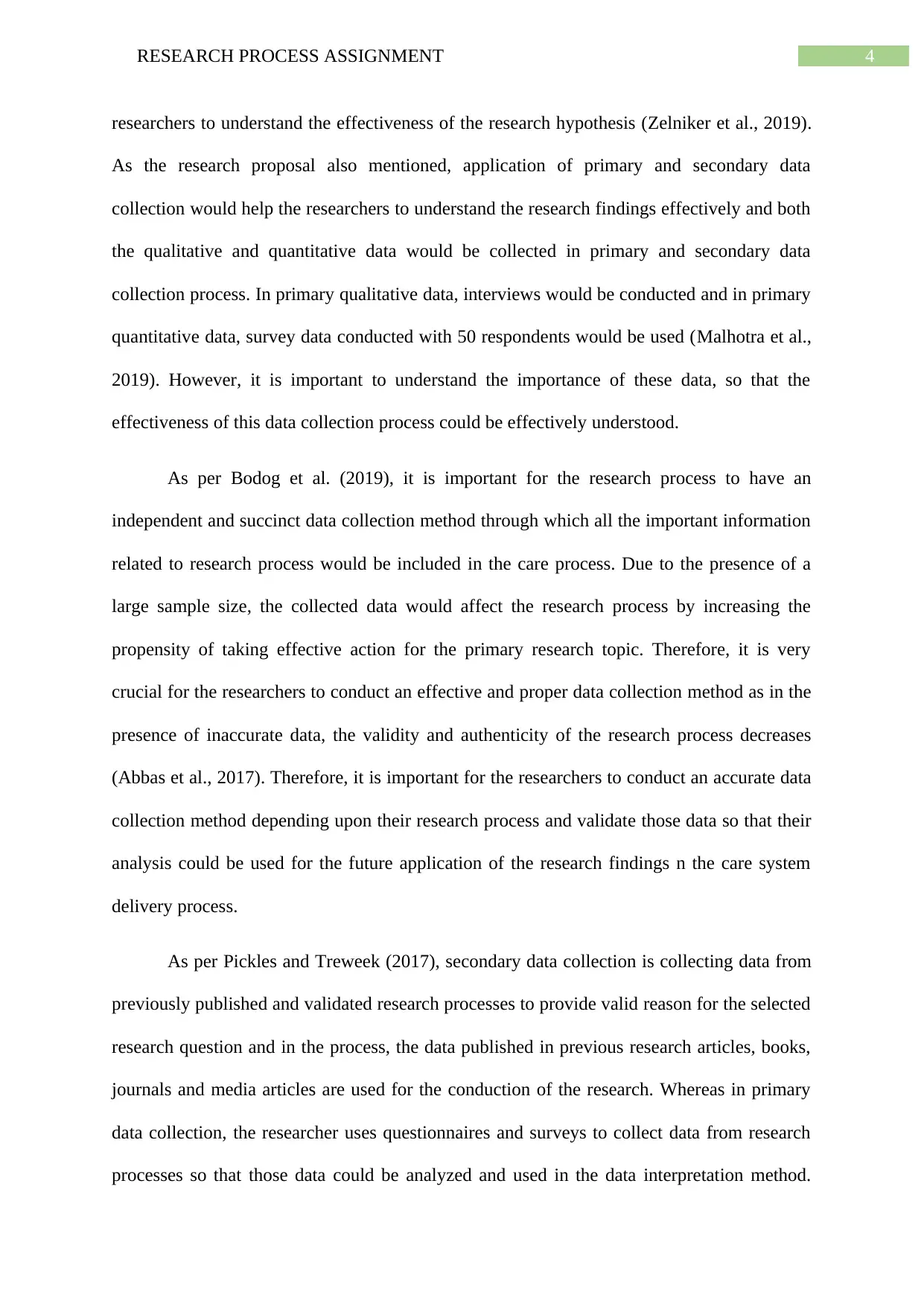
4RESEARCH PROCESS ASSIGNMENT
researchers to understand the effectiveness of the research hypothesis (Zelniker et al., 2019).
As the research proposal also mentioned, application of primary and secondary data
collection would help the researchers to understand the research findings effectively and both
the qualitative and quantitative data would be collected in primary and secondary data
collection process. In primary qualitative data, interviews would be conducted and in primary
quantitative data, survey data conducted with 50 respondents would be used (Malhotra et al.,
2019). However, it is important to understand the importance of these data, so that the
effectiveness of this data collection process could be effectively understood.
As per Bodog et al. (2019), it is important for the research process to have an
independent and succinct data collection method through which all the important information
related to research process would be included in the care process. Due to the presence of a
large sample size, the collected data would affect the research process by increasing the
propensity of taking effective action for the primary research topic. Therefore, it is very
crucial for the researchers to conduct an effective and proper data collection method as in the
presence of inaccurate data, the validity and authenticity of the research process decreases
(Abbas et al., 2017). Therefore, it is important for the researchers to conduct an accurate data
collection method depending upon their research process and validate those data so that their
analysis could be used for the future application of the research findings n the care system
delivery process.
As per Pickles and Treweek (2017), secondary data collection is collecting data from
previously published and validated research processes to provide valid reason for the selected
research question and in the process, the data published in previous research articles, books,
journals and media articles are used for the conduction of the research. Whereas in primary
data collection, the researcher uses questionnaires and surveys to collect data from research
processes so that those data could be analyzed and used in the data interpretation method.
researchers to understand the effectiveness of the research hypothesis (Zelniker et al., 2019).
As the research proposal also mentioned, application of primary and secondary data
collection would help the researchers to understand the research findings effectively and both
the qualitative and quantitative data would be collected in primary and secondary data
collection process. In primary qualitative data, interviews would be conducted and in primary
quantitative data, survey data conducted with 50 respondents would be used (Malhotra et al.,
2019). However, it is important to understand the importance of these data, so that the
effectiveness of this data collection process could be effectively understood.
As per Bodog et al. (2019), it is important for the research process to have an
independent and succinct data collection method through which all the important information
related to research process would be included in the care process. Due to the presence of a
large sample size, the collected data would affect the research process by increasing the
propensity of taking effective action for the primary research topic. Therefore, it is very
crucial for the researchers to conduct an effective and proper data collection method as in the
presence of inaccurate data, the validity and authenticity of the research process decreases
(Abbas et al., 2017). Therefore, it is important for the researchers to conduct an accurate data
collection method depending upon their research process and validate those data so that their
analysis could be used for the future application of the research findings n the care system
delivery process.
As per Pickles and Treweek (2017), secondary data collection is collecting data from
previously published and validated research processes to provide valid reason for the selected
research question and in the process, the data published in previous research articles, books,
journals and media articles are used for the conduction of the research. Whereas in primary
data collection, the researcher uses questionnaires and surveys to collect data from research
processes so that those data could be analyzed and used in the data interpretation method.
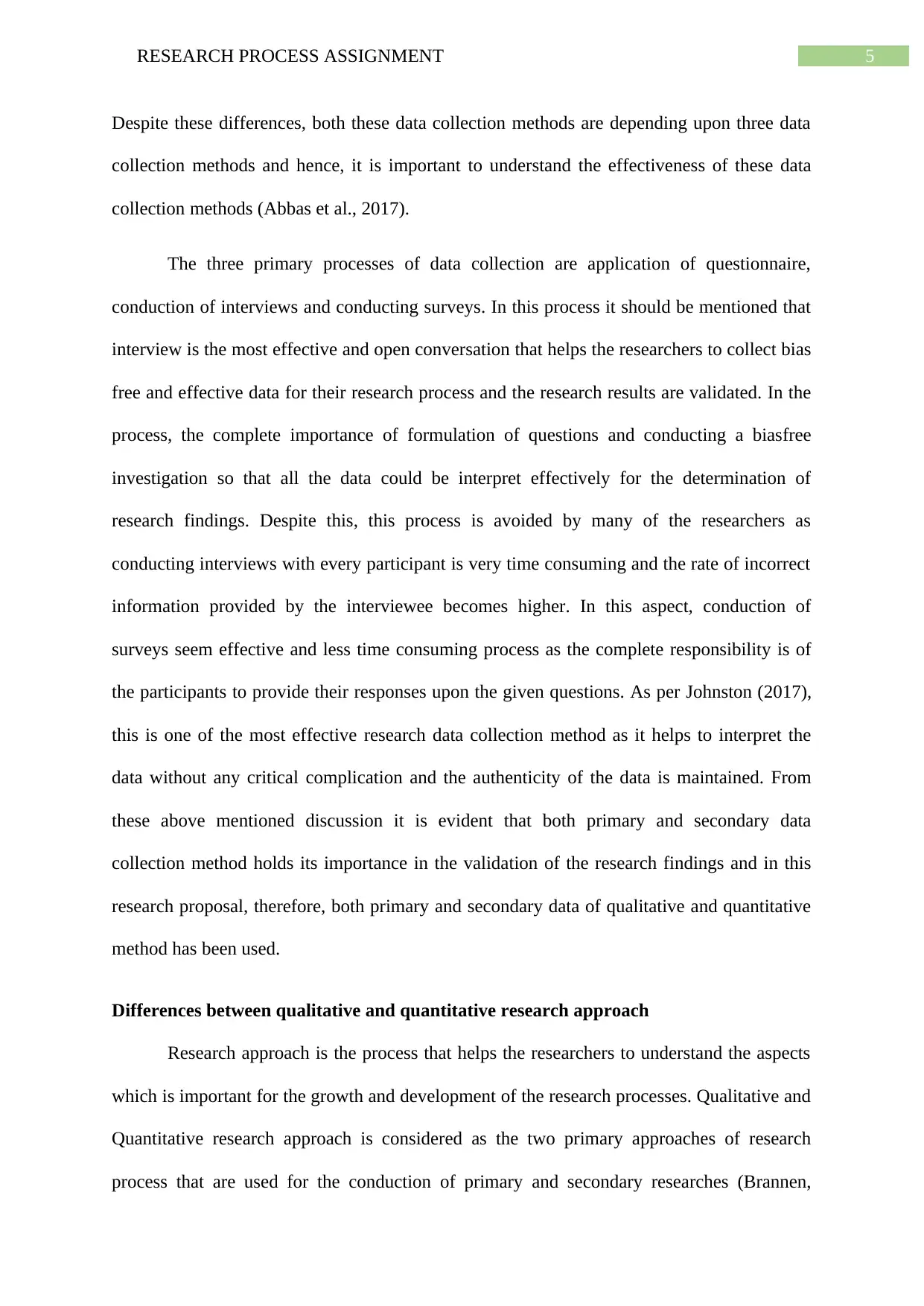
5RESEARCH PROCESS ASSIGNMENT
Despite these differences, both these data collection methods are depending upon three data
collection methods and hence, it is important to understand the effectiveness of these data
collection methods (Abbas et al., 2017).
The three primary processes of data collection are application of questionnaire,
conduction of interviews and conducting surveys. In this process it should be mentioned that
interview is the most effective and open conversation that helps the researchers to collect bias
free and effective data for their research process and the research results are validated. In the
process, the complete importance of formulation of questions and conducting a biasfree
investigation so that all the data could be interpret effectively for the determination of
research findings. Despite this, this process is avoided by many of the researchers as
conducting interviews with every participant is very time consuming and the rate of incorrect
information provided by the interviewee becomes higher. In this aspect, conduction of
surveys seem effective and less time consuming process as the complete responsibility is of
the participants to provide their responses upon the given questions. As per Johnston (2017),
this is one of the most effective research data collection method as it helps to interpret the
data without any critical complication and the authenticity of the data is maintained. From
these above mentioned discussion it is evident that both primary and secondary data
collection method holds its importance in the validation of the research findings and in this
research proposal, therefore, both primary and secondary data of qualitative and quantitative
method has been used.
Differences between qualitative and quantitative research approach
Research approach is the process that helps the researchers to understand the aspects
which is important for the growth and development of the research processes. Qualitative and
Quantitative research approach is considered as the two primary approaches of research
process that are used for the conduction of primary and secondary researches (Brannen,
Despite these differences, both these data collection methods are depending upon three data
collection methods and hence, it is important to understand the effectiveness of these data
collection methods (Abbas et al., 2017).
The three primary processes of data collection are application of questionnaire,
conduction of interviews and conducting surveys. In this process it should be mentioned that
interview is the most effective and open conversation that helps the researchers to collect bias
free and effective data for their research process and the research results are validated. In the
process, the complete importance of formulation of questions and conducting a biasfree
investigation so that all the data could be interpret effectively for the determination of
research findings. Despite this, this process is avoided by many of the researchers as
conducting interviews with every participant is very time consuming and the rate of incorrect
information provided by the interviewee becomes higher. In this aspect, conduction of
surveys seem effective and less time consuming process as the complete responsibility is of
the participants to provide their responses upon the given questions. As per Johnston (2017),
this is one of the most effective research data collection method as it helps to interpret the
data without any critical complication and the authenticity of the data is maintained. From
these above mentioned discussion it is evident that both primary and secondary data
collection method holds its importance in the validation of the research findings and in this
research proposal, therefore, both primary and secondary data of qualitative and quantitative
method has been used.
Differences between qualitative and quantitative research approach
Research approach is the process that helps the researchers to understand the aspects
which is important for the growth and development of the research processes. Qualitative and
Quantitative research approach is considered as the two primary approaches of research
process that are used for the conduction of primary and secondary researches (Brannen,
⊘ This is a preview!⊘
Do you want full access?
Subscribe today to unlock all pages.

Trusted by 1+ million students worldwide
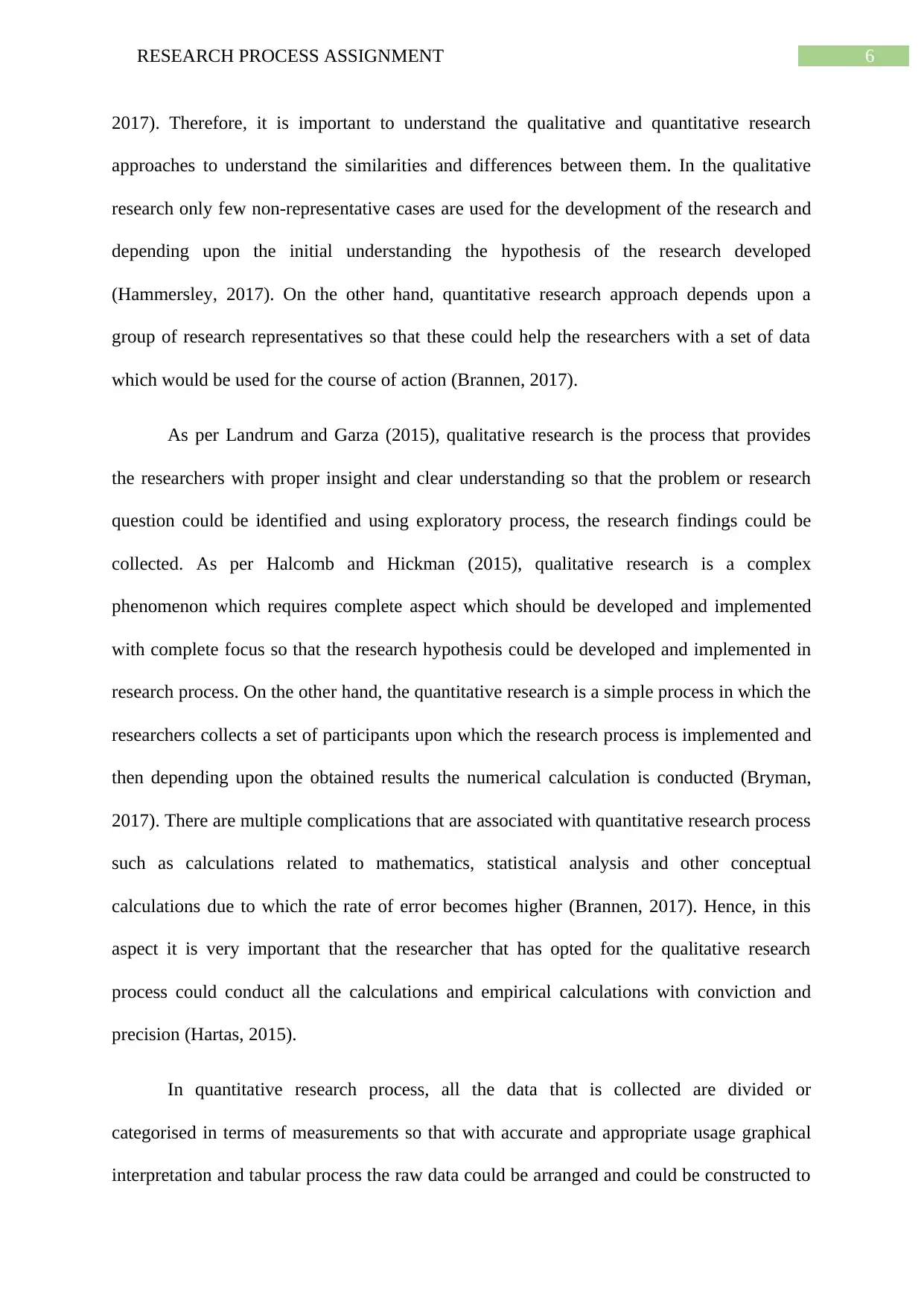
6RESEARCH PROCESS ASSIGNMENT
2017). Therefore, it is important to understand the qualitative and quantitative research
approaches to understand the similarities and differences between them. In the qualitative
research only few non-representative cases are used for the development of the research and
depending upon the initial understanding the hypothesis of the research developed
(Hammersley, 2017). On the other hand, quantitative research approach depends upon a
group of research representatives so that these could help the researchers with a set of data
which would be used for the course of action (Brannen, 2017).
As per Landrum and Garza (2015), qualitative research is the process that provides
the researchers with proper insight and clear understanding so that the problem or research
question could be identified and using exploratory process, the research findings could be
collected. As per Halcomb and Hickman (2015), qualitative research is a complex
phenomenon which requires complete aspect which should be developed and implemented
with complete focus so that the research hypothesis could be developed and implemented in
research process. On the other hand, the quantitative research is a simple process in which the
researchers collects a set of participants upon which the research process is implemented and
then depending upon the obtained results the numerical calculation is conducted (Bryman,
2017). There are multiple complications that are associated with quantitative research process
such as calculations related to mathematics, statistical analysis and other conceptual
calculations due to which the rate of error becomes higher (Brannen, 2017). Hence, in this
aspect it is very important that the researcher that has opted for the qualitative research
process could conduct all the calculations and empirical calculations with conviction and
precision (Hartas, 2015).
In quantitative research process, all the data that is collected are divided or
categorised in terms of measurements so that with accurate and appropriate usage graphical
interpretation and tabular process the raw data could be arranged and could be constructed to
2017). Therefore, it is important to understand the qualitative and quantitative research
approaches to understand the similarities and differences between them. In the qualitative
research only few non-representative cases are used for the development of the research and
depending upon the initial understanding the hypothesis of the research developed
(Hammersley, 2017). On the other hand, quantitative research approach depends upon a
group of research representatives so that these could help the researchers with a set of data
which would be used for the course of action (Brannen, 2017).
As per Landrum and Garza (2015), qualitative research is the process that provides
the researchers with proper insight and clear understanding so that the problem or research
question could be identified and using exploratory process, the research findings could be
collected. As per Halcomb and Hickman (2015), qualitative research is a complex
phenomenon which requires complete aspect which should be developed and implemented
with complete focus so that the research hypothesis could be developed and implemented in
research process. On the other hand, the quantitative research is a simple process in which the
researchers collects a set of participants upon which the research process is implemented and
then depending upon the obtained results the numerical calculation is conducted (Bryman,
2017). There are multiple complications that are associated with quantitative research process
such as calculations related to mathematics, statistical analysis and other conceptual
calculations due to which the rate of error becomes higher (Brannen, 2017). Hence, in this
aspect it is very important that the researcher that has opted for the qualitative research
process could conduct all the calculations and empirical calculations with conviction and
precision (Hartas, 2015).
In quantitative research process, all the data that is collected are divided or
categorised in terms of measurements so that with accurate and appropriate usage graphical
interpretation and tabular process the raw data could be arranged and could be constructed to
Paraphrase This Document
Need a fresh take? Get an instant paraphrase of this document with our AI Paraphraser
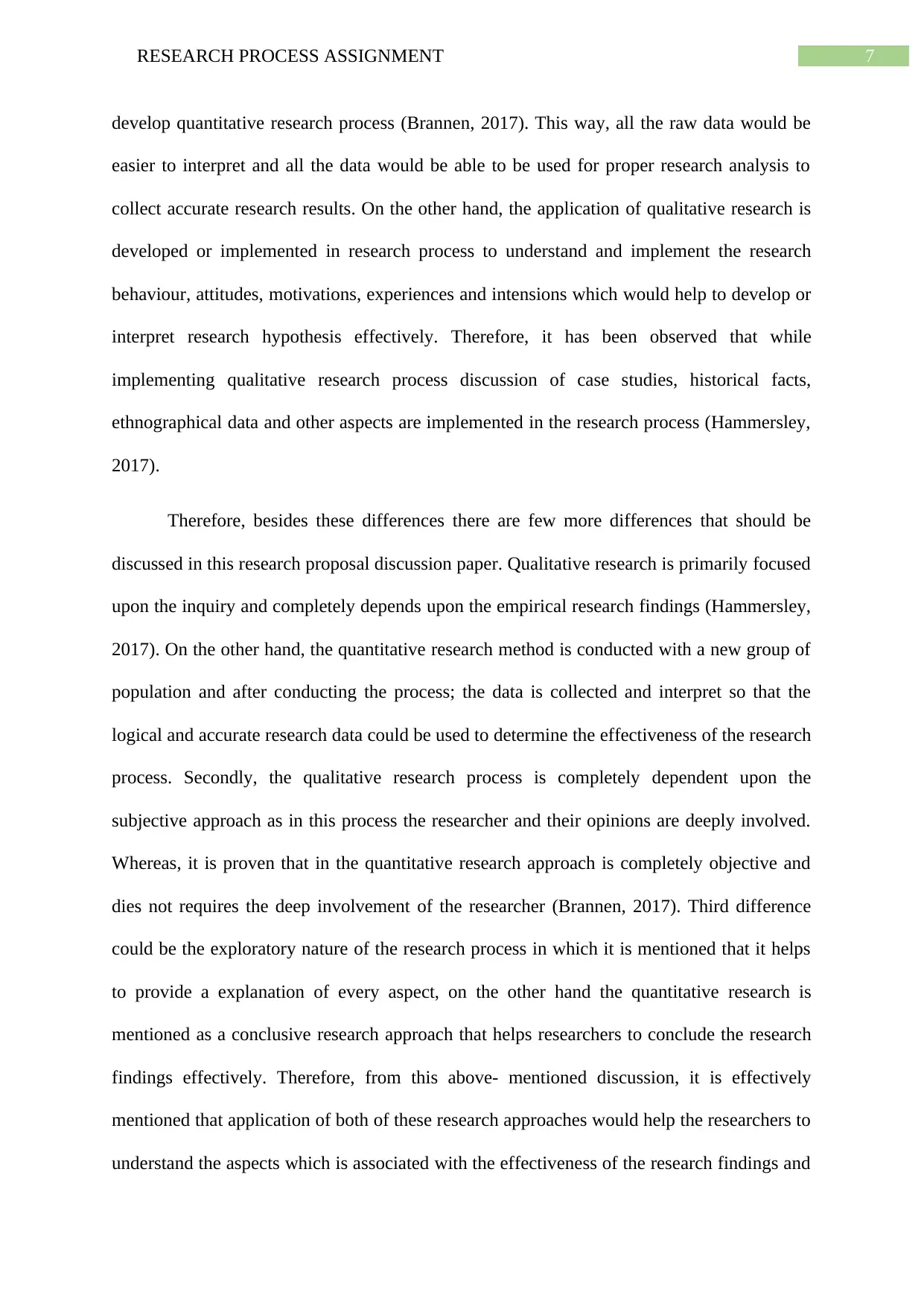
7RESEARCH PROCESS ASSIGNMENT
develop quantitative research process (Brannen, 2017). This way, all the raw data would be
easier to interpret and all the data would be able to be used for proper research analysis to
collect accurate research results. On the other hand, the application of qualitative research is
developed or implemented in research process to understand and implement the research
behaviour, attitudes, motivations, experiences and intensions which would help to develop or
interpret research hypothesis effectively. Therefore, it has been observed that while
implementing qualitative research process discussion of case studies, historical facts,
ethnographical data and other aspects are implemented in the research process (Hammersley,
2017).
Therefore, besides these differences there are few more differences that should be
discussed in this research proposal discussion paper. Qualitative research is primarily focused
upon the inquiry and completely depends upon the empirical research findings (Hammersley,
2017). On the other hand, the quantitative research method is conducted with a new group of
population and after conducting the process; the data is collected and interpret so that the
logical and accurate research data could be used to determine the effectiveness of the research
process. Secondly, the qualitative research process is completely dependent upon the
subjective approach as in this process the researcher and their opinions are deeply involved.
Whereas, it is proven that in the quantitative research approach is completely objective and
dies not requires the deep involvement of the researcher (Brannen, 2017). Third difference
could be the exploratory nature of the research process in which it is mentioned that it helps
to provide a explanation of every aspect, on the other hand the quantitative research is
mentioned as a conclusive research approach that helps researchers to conclude the research
findings effectively. Therefore, from this above- mentioned discussion, it is effectively
mentioned that application of both of these research approaches would help the researchers to
understand the aspects which is associated with the effectiveness of the research findings and
develop quantitative research process (Brannen, 2017). This way, all the raw data would be
easier to interpret and all the data would be able to be used for proper research analysis to
collect accurate research results. On the other hand, the application of qualitative research is
developed or implemented in research process to understand and implement the research
behaviour, attitudes, motivations, experiences and intensions which would help to develop or
interpret research hypothesis effectively. Therefore, it has been observed that while
implementing qualitative research process discussion of case studies, historical facts,
ethnographical data and other aspects are implemented in the research process (Hammersley,
2017).
Therefore, besides these differences there are few more differences that should be
discussed in this research proposal discussion paper. Qualitative research is primarily focused
upon the inquiry and completely depends upon the empirical research findings (Hammersley,
2017). On the other hand, the quantitative research method is conducted with a new group of
population and after conducting the process; the data is collected and interpret so that the
logical and accurate research data could be used to determine the effectiveness of the research
process. Secondly, the qualitative research process is completely dependent upon the
subjective approach as in this process the researcher and their opinions are deeply involved.
Whereas, it is proven that in the quantitative research approach is completely objective and
dies not requires the deep involvement of the researcher (Brannen, 2017). Third difference
could be the exploratory nature of the research process in which it is mentioned that it helps
to provide a explanation of every aspect, on the other hand the quantitative research is
mentioned as a conclusive research approach that helps researchers to conclude the research
findings effectively. Therefore, from this above- mentioned discussion, it is effectively
mentioned that application of both of these research approaches would help the researchers to
understand the aspects which is associated with the effectiveness of the research findings and
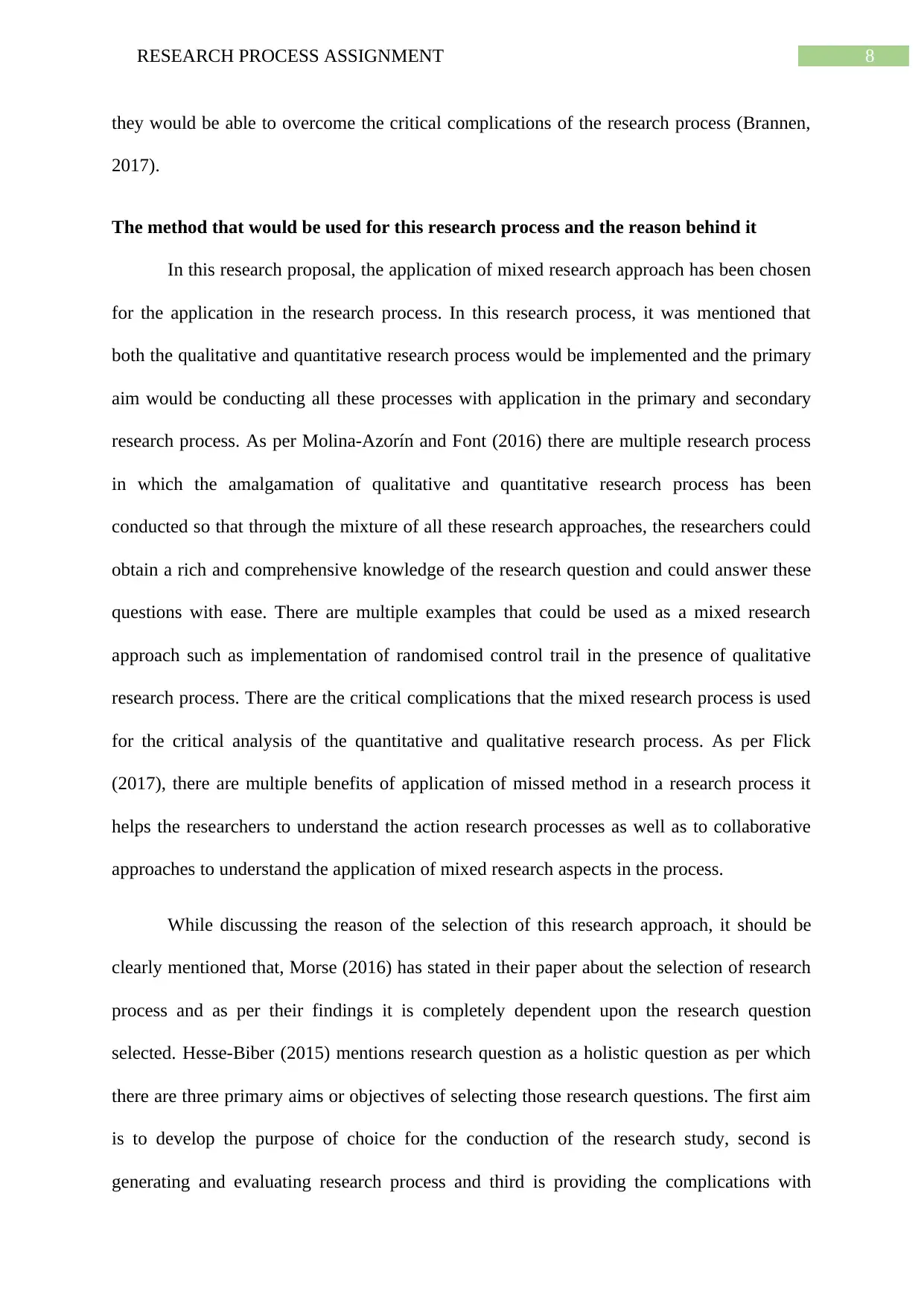
8RESEARCH PROCESS ASSIGNMENT
they would be able to overcome the critical complications of the research process (Brannen,
2017).
The method that would be used for this research process and the reason behind it
In this research proposal, the application of mixed research approach has been chosen
for the application in the research process. In this research process, it was mentioned that
both the qualitative and quantitative research process would be implemented and the primary
aim would be conducting all these processes with application in the primary and secondary
research process. As per Molina-Azorín and Font (2016) there are multiple research process
in which the amalgamation of qualitative and quantitative research process has been
conducted so that through the mixture of all these research approaches, the researchers could
obtain a rich and comprehensive knowledge of the research question and could answer these
questions with ease. There are multiple examples that could be used as a mixed research
approach such as implementation of randomised control trail in the presence of qualitative
research process. There are the critical complications that the mixed research process is used
for the critical analysis of the quantitative and qualitative research process. As per Flick
(2017), there are multiple benefits of application of missed method in a research process it
helps the researchers to understand the action research processes as well as to collaborative
approaches to understand the application of mixed research aspects in the process.
While discussing the reason of the selection of this research approach, it should be
clearly mentioned that, Morse (2016) has stated in their paper about the selection of research
process and as per their findings it is completely dependent upon the research question
selected. Hesse-Biber (2015) mentions research question as a holistic question as per which
there are three primary aims or objectives of selecting those research questions. The first aim
is to develop the purpose of choice for the conduction of the research study, second is
generating and evaluating research process and third is providing the complications with
they would be able to overcome the critical complications of the research process (Brannen,
2017).
The method that would be used for this research process and the reason behind it
In this research proposal, the application of mixed research approach has been chosen
for the application in the research process. In this research process, it was mentioned that
both the qualitative and quantitative research process would be implemented and the primary
aim would be conducting all these processes with application in the primary and secondary
research process. As per Molina-Azorín and Font (2016) there are multiple research process
in which the amalgamation of qualitative and quantitative research process has been
conducted so that through the mixture of all these research approaches, the researchers could
obtain a rich and comprehensive knowledge of the research question and could answer these
questions with ease. There are multiple examples that could be used as a mixed research
approach such as implementation of randomised control trail in the presence of qualitative
research process. There are the critical complications that the mixed research process is used
for the critical analysis of the quantitative and qualitative research process. As per Flick
(2017), there are multiple benefits of application of missed method in a research process it
helps the researchers to understand the action research processes as well as to collaborative
approaches to understand the application of mixed research aspects in the process.
While discussing the reason of the selection of this research approach, it should be
clearly mentioned that, Morse (2016) has stated in their paper about the selection of research
process and as per their findings it is completely dependent upon the research question
selected. Hesse-Biber (2015) mentions research question as a holistic question as per which
there are three primary aims or objectives of selecting those research questions. The first aim
is to develop the purpose of choice for the conduction of the research study, second is
generating and evaluating research process and third is providing the complications with
⊘ This is a preview!⊘
Do you want full access?
Subscribe today to unlock all pages.

Trusted by 1+ million students worldwide
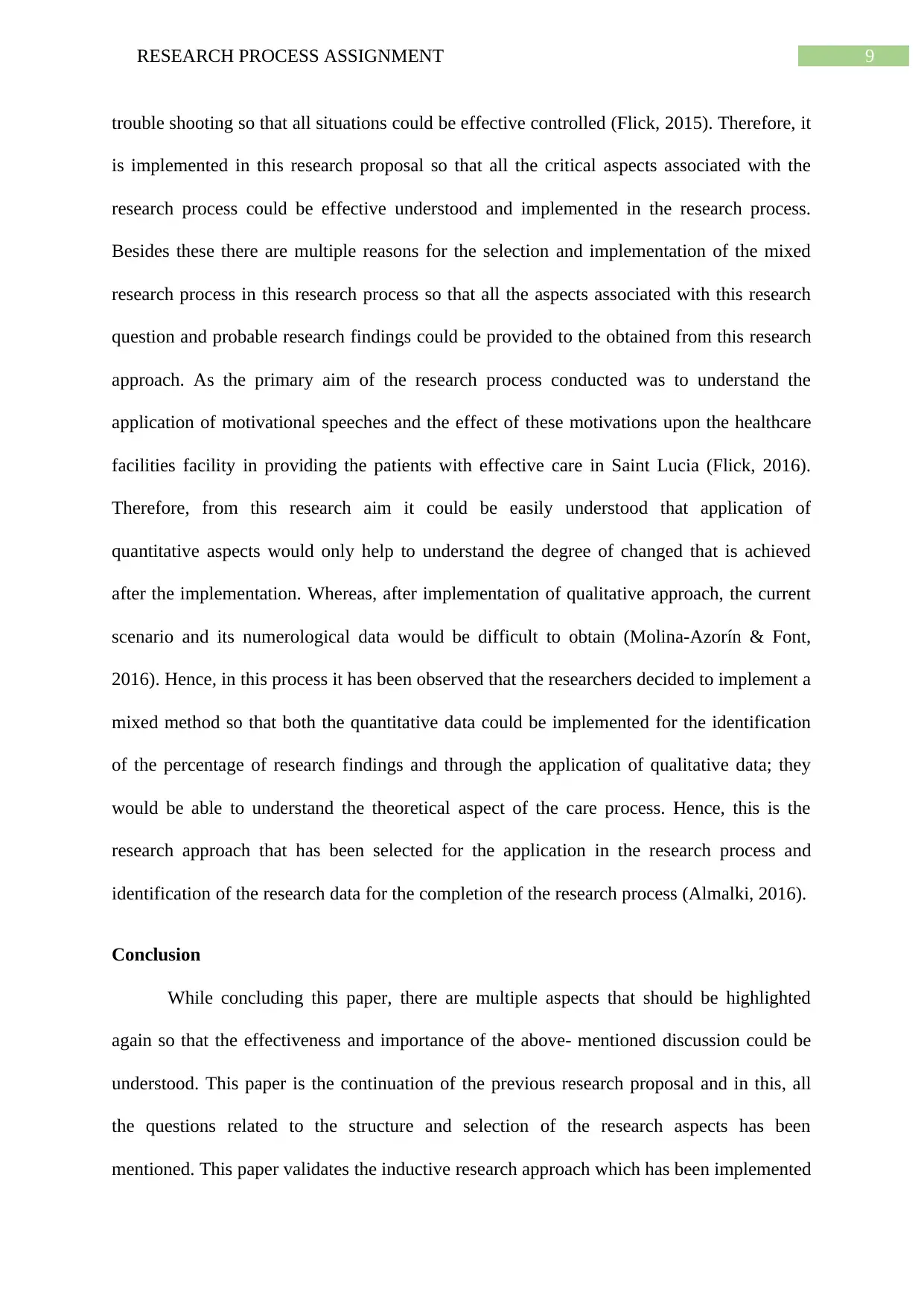
9RESEARCH PROCESS ASSIGNMENT
trouble shooting so that all situations could be effective controlled (Flick, 2015). Therefore, it
is implemented in this research proposal so that all the critical aspects associated with the
research process could be effective understood and implemented in the research process.
Besides these there are multiple reasons for the selection and implementation of the mixed
research process in this research process so that all the aspects associated with this research
question and probable research findings could be provided to the obtained from this research
approach. As the primary aim of the research process conducted was to understand the
application of motivational speeches and the effect of these motivations upon the healthcare
facilities facility in providing the patients with effective care in Saint Lucia (Flick, 2016).
Therefore, from this research aim it could be easily understood that application of
quantitative aspects would only help to understand the degree of changed that is achieved
after the implementation. Whereas, after implementation of qualitative approach, the current
scenario and its numerological data would be difficult to obtain (Molina-Azorín & Font,
2016). Hence, in this process it has been observed that the researchers decided to implement a
mixed method so that both the quantitative data could be implemented for the identification
of the percentage of research findings and through the application of qualitative data; they
would be able to understand the theoretical aspect of the care process. Hence, this is the
research approach that has been selected for the application in the research process and
identification of the research data for the completion of the research process (Almalki, 2016).
Conclusion
While concluding this paper, there are multiple aspects that should be highlighted
again so that the effectiveness and importance of the above- mentioned discussion could be
understood. This paper is the continuation of the previous research proposal and in this, all
the questions related to the structure and selection of the research aspects has been
mentioned. This paper validates the inductive research approach which has been implemented
trouble shooting so that all situations could be effective controlled (Flick, 2015). Therefore, it
is implemented in this research proposal so that all the critical aspects associated with the
research process could be effective understood and implemented in the research process.
Besides these there are multiple reasons for the selection and implementation of the mixed
research process in this research process so that all the aspects associated with this research
question and probable research findings could be provided to the obtained from this research
approach. As the primary aim of the research process conducted was to understand the
application of motivational speeches and the effect of these motivations upon the healthcare
facilities facility in providing the patients with effective care in Saint Lucia (Flick, 2016).
Therefore, from this research aim it could be easily understood that application of
quantitative aspects would only help to understand the degree of changed that is achieved
after the implementation. Whereas, after implementation of qualitative approach, the current
scenario and its numerological data would be difficult to obtain (Molina-Azorín & Font,
2016). Hence, in this process it has been observed that the researchers decided to implement a
mixed method so that both the quantitative data could be implemented for the identification
of the percentage of research findings and through the application of qualitative data; they
would be able to understand the theoretical aspect of the care process. Hence, this is the
research approach that has been selected for the application in the research process and
identification of the research data for the completion of the research process (Almalki, 2016).
Conclusion
While concluding this paper, there are multiple aspects that should be highlighted
again so that the effectiveness and importance of the above- mentioned discussion could be
understood. This paper is the continuation of the previous research proposal and in this, all
the questions related to the structure and selection of the research aspects has been
mentioned. This paper validates the inductive research approach which has been implemented
Paraphrase This Document
Need a fresh take? Get an instant paraphrase of this document with our AI Paraphraser
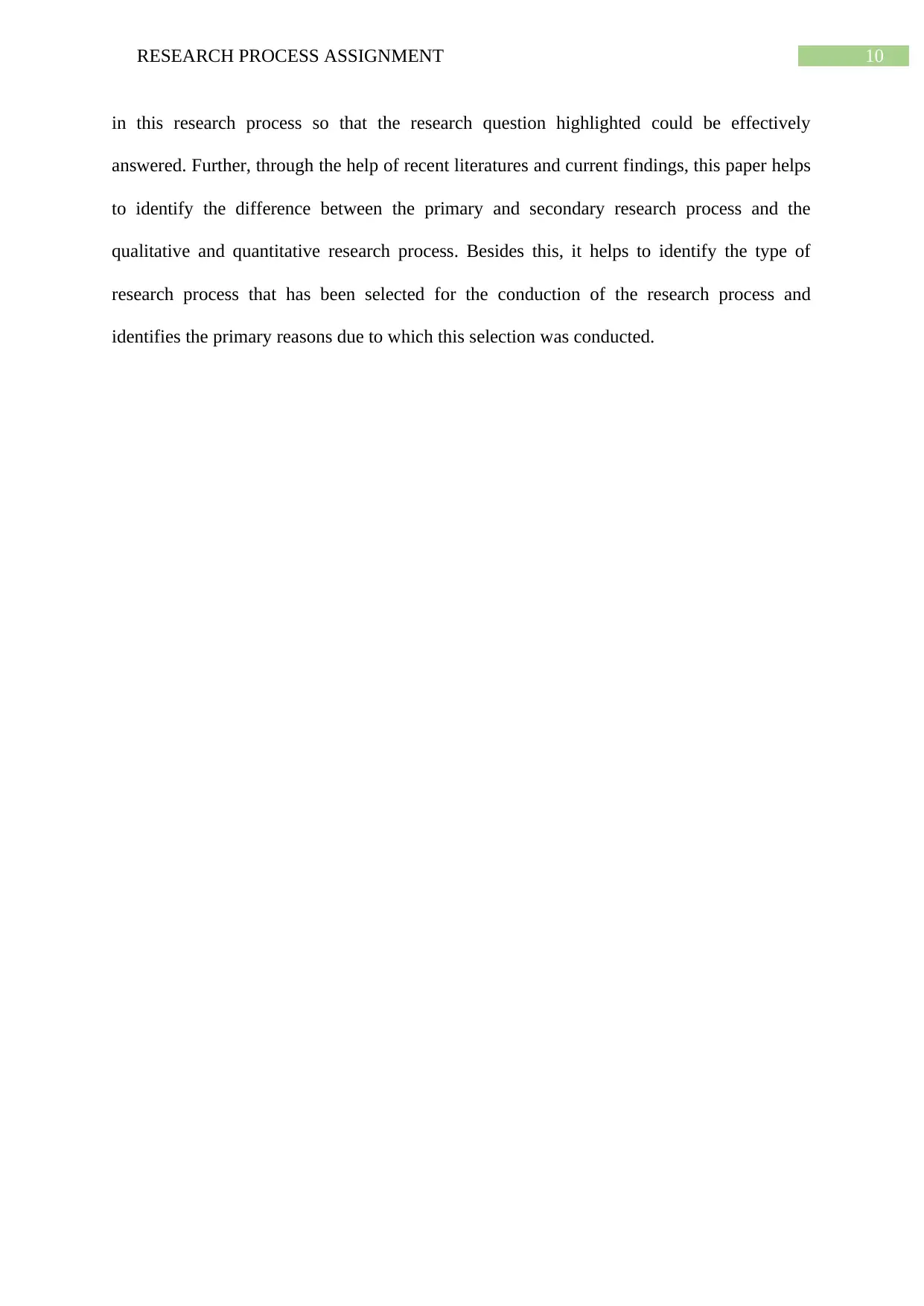
10RESEARCH PROCESS ASSIGNMENT
in this research process so that the research question highlighted could be effectively
answered. Further, through the help of recent literatures and current findings, this paper helps
to identify the difference between the primary and secondary research process and the
qualitative and quantitative research process. Besides this, it helps to identify the type of
research process that has been selected for the conduction of the research process and
identifies the primary reasons due to which this selection was conducted.
in this research process so that the research question highlighted could be effectively
answered. Further, through the help of recent literatures and current findings, this paper helps
to identify the difference between the primary and secondary research process and the
qualitative and quantitative research process. Besides this, it helps to identify the type of
research process that has been selected for the conduction of the research process and
identifies the primary reasons due to which this selection was conducted.
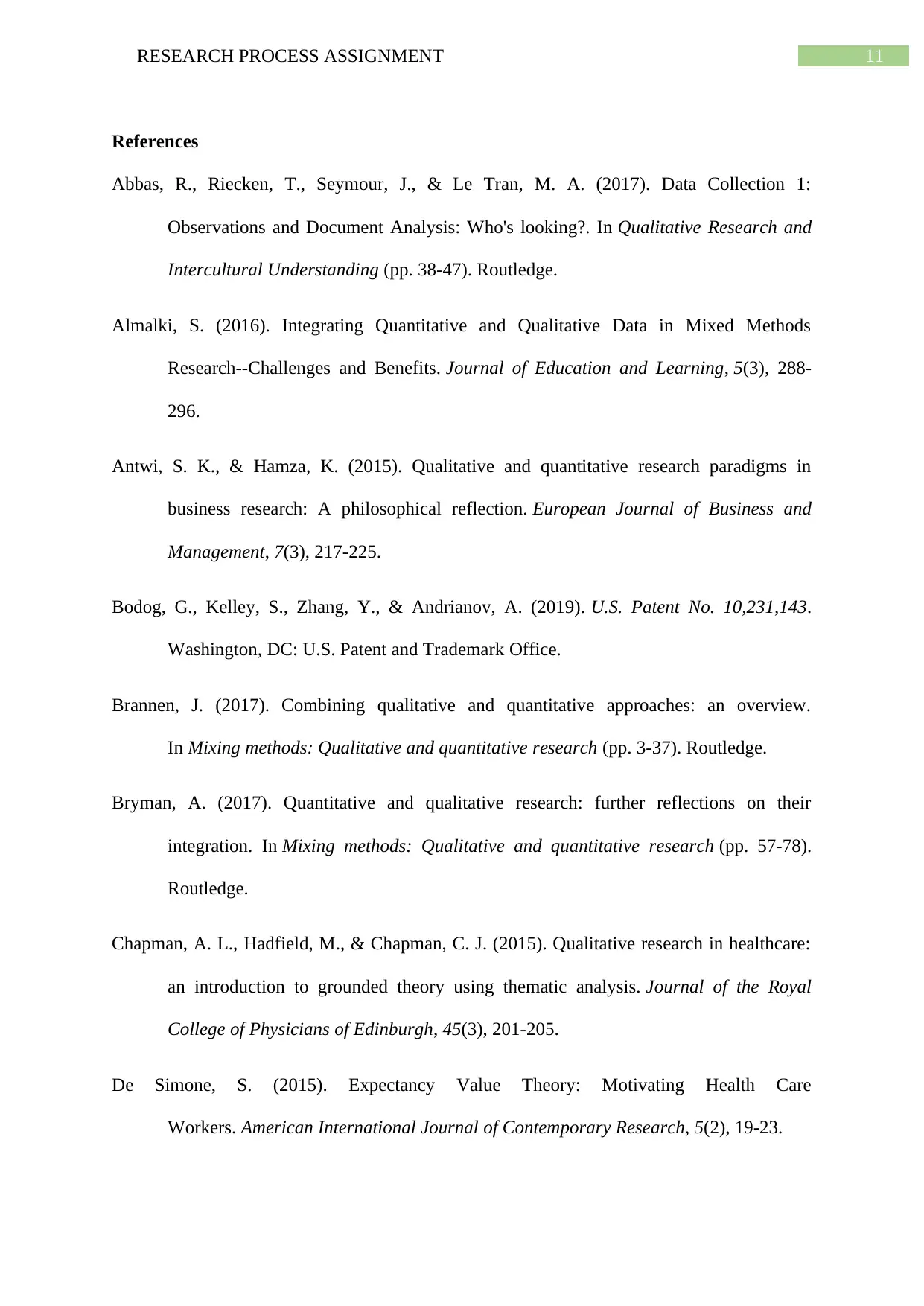
11RESEARCH PROCESS ASSIGNMENT
References
Abbas, R., Riecken, T., Seymour, J., & Le Tran, M. A. (2017). Data Collection 1:
Observations and Document Analysis: Who's looking?. In Qualitative Research and
Intercultural Understanding (pp. 38-47). Routledge.
Almalki, S. (2016). Integrating Quantitative and Qualitative Data in Mixed Methods
Research--Challenges and Benefits. Journal of Education and Learning, 5(3), 288-
296.
Antwi, S. K., & Hamza, K. (2015). Qualitative and quantitative research paradigms in
business research: A philosophical reflection. European Journal of Business and
Management, 7(3), 217-225.
Bodog, G., Kelley, S., Zhang, Y., & Andrianov, A. (2019). U.S. Patent No. 10,231,143.
Washington, DC: U.S. Patent and Trademark Office.
Brannen, J. (2017). Combining qualitative and quantitative approaches: an overview.
In Mixing methods: Qualitative and quantitative research (pp. 3-37). Routledge.
Bryman, A. (2017). Quantitative and qualitative research: further reflections on their
integration. In Mixing methods: Qualitative and quantitative research (pp. 57-78).
Routledge.
Chapman, A. L., Hadfield, M., & Chapman, C. J. (2015). Qualitative research in healthcare:
an introduction to grounded theory using thematic analysis. Journal of the Royal
College of Physicians of Edinburgh, 45(3), 201-205.
De Simone, S. (2015). Expectancy Value Theory: Motivating Health Care
Workers. American International Journal of Contemporary Research, 5(2), 19-23.
References
Abbas, R., Riecken, T., Seymour, J., & Le Tran, M. A. (2017). Data Collection 1:
Observations and Document Analysis: Who's looking?. In Qualitative Research and
Intercultural Understanding (pp. 38-47). Routledge.
Almalki, S. (2016). Integrating Quantitative and Qualitative Data in Mixed Methods
Research--Challenges and Benefits. Journal of Education and Learning, 5(3), 288-
296.
Antwi, S. K., & Hamza, K. (2015). Qualitative and quantitative research paradigms in
business research: A philosophical reflection. European Journal of Business and
Management, 7(3), 217-225.
Bodog, G., Kelley, S., Zhang, Y., & Andrianov, A. (2019). U.S. Patent No. 10,231,143.
Washington, DC: U.S. Patent and Trademark Office.
Brannen, J. (2017). Combining qualitative and quantitative approaches: an overview.
In Mixing methods: Qualitative and quantitative research (pp. 3-37). Routledge.
Bryman, A. (2017). Quantitative and qualitative research: further reflections on their
integration. In Mixing methods: Qualitative and quantitative research (pp. 57-78).
Routledge.
Chapman, A. L., Hadfield, M., & Chapman, C. J. (2015). Qualitative research in healthcare:
an introduction to grounded theory using thematic analysis. Journal of the Royal
College of Physicians of Edinburgh, 45(3), 201-205.
De Simone, S. (2015). Expectancy Value Theory: Motivating Health Care
Workers. American International Journal of Contemporary Research, 5(2), 19-23.
⊘ This is a preview!⊘
Do you want full access?
Subscribe today to unlock all pages.

Trusted by 1+ million students worldwide
1 out of 14
Related Documents
Your All-in-One AI-Powered Toolkit for Academic Success.
+13062052269
info@desklib.com
Available 24*7 on WhatsApp / Email
![[object Object]](/_next/static/media/star-bottom.7253800d.svg)
Unlock your academic potential
Copyright © 2020–2025 A2Z Services. All Rights Reserved. Developed and managed by ZUCOL.





